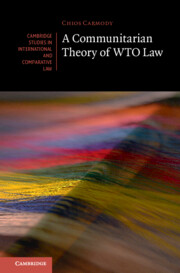324 results
Paulin Hountondji: The Struggle for Meaning and the Struggle for Action
-
- Journal:
- African Studies Review , First View
- Published online by Cambridge University Press:
- 29 April 2024, pp. 1-5
-
- Article
-
- You have access
- HTML
- Export citation
Legitimate governance in international politics: Towards a relational theory of legitimation
-
- Journal:
- Review of International Studies , First View
- Published online by Cambridge University Press:
- 08 March 2024, pp. 1-20
-
- Article
-
- You have access
- Open access
- HTML
- Export citation
2 - Evaluating New Advances in Alzheimer’s Research
-
- Book:
- Dispatches from the Land of Alzheimer's
- Published online:
- 19 January 2024
- Print publication:
- 22 February 2024, pp 9-11
-
- Chapter
- Export citation
1 - Introduction
-
- Book:
- Regression Inside Out
- Published online:
- 21 March 2024
- Print publication:
- 22 February 2024, pp 1-14
-
- Chapter
- Export citation
10 - Conclusion
- from Part III - RIO as a Gateway
-
- Book:
- Regression Inside Out
- Published online:
- 21 March 2024
- Print publication:
- 22 February 2024, pp 220-226
-
- Chapter
- Export citation
Introduction
-
- Book:
- Three Faces of Sun Tzu
- Published online:
- 07 March 2024
- Print publication:
- 15 February 2024, pp 1-22
-
- Chapter
- Export citation
Who, Why, When, and Where From? The Peopling of the Canary Islands and the Challenges of Archaeometry
-
- Journal:
- European Journal of Archaeology / Volume 27 / Issue 2 / May 2024
- Published online by Cambridge University Press:
- 15 February 2024, pp. 192-209
- Print publication:
- May 2024
-
- Article
-
- You have access
- Open access
- HTML
- Export citation
Introduction
-
- Book:
- Three Faces of Sun Tzu
- Published online:
- 07 March 2024
- Print publication:
- 15 February 2024, pp 1-22
-
- Chapter
- Export citation
Cultural evolution: A review of theoretical challenges
-
- Journal:
- Evolutionary Human Sciences / Volume 6 / 2024
- Published online by Cambridge University Press:
- 13 February 2024, e12
-
- Article
-
- You have access
- Open access
- HTML
- Export citation
Chapter 13 - Virtue Science and Psychology
- from Part IV - The Science and Practice of Virtue
-
- Book:
- The Science of Virtue
- Published online:
- 11 January 2024
- Print publication:
- 01 February 2024, pp 310-332
-
- Chapter
- Export citation
6 - Sector Theorists Should Embrace a Social Economy Perspective
- from Part II - Reflections and Refinements
-
-
- Book:
- Reimagining Nonprofits
- Published online:
- 11 January 2024
- Print publication:
- 01 February 2024, pp 113-132
-
- Chapter
- Export citation
4 - What Makes Good Nonprofit Sector Theory?
- from Part I - Overviews
-
-
- Book:
- Reimagining Nonprofits
- Published online:
- 11 January 2024
- Print publication:
- 01 February 2024, pp 71-88
-
- Chapter
- Export citation
Chapter 3 - Theory
-
- Book:
- Pragmatism and Methodology
- Published online:
- 04 January 2024
- Print publication:
- 25 January 2024, pp 49-73
-
- Chapter
-
- You have access
- Open access
- HTML
- Export citation
8 - Conclusion
-
- Book:
- Academic Freedom and the Transnational Production of Knowledge
- Published online:
- 04 January 2024
- Print publication:
- 25 January 2024, pp 159-178
-
- Chapter
- Export citation
2 - How Institutional Constraints and Conjunctural Opportunities Condition Populism’s Threat to Democracy
-
- Book:
- Democracy's Resilience to Populism's Threat
- Published online:
- 11 January 2024
- Print publication:
- 25 January 2024, pp 30-73
-
- Chapter
- Export citation
Locally Tight Programs
-
- Journal:
- Theory and Practice of Logic Programming , First View
- Published online by Cambridge University Press:
- 19 January 2024, pp. 1-31
-
- Article
-
- You have access
- Open access
- HTML
- Export citation
1 - A Theory of WTO Law
-
- Book:
- A Communitarian Theory of WTO Law
- Published online:
- 14 December 2023
- Print publication:
- 21 December 2023, pp 1-54
-
- Chapter
- Export citation
7 - Management, Leadership and Change
- from Part 1 - The Public Health Toolkit
-
-
- Book:
- Essential Public Health
- Published online:
- 01 December 2023
- Print publication:
- 14 December 2023, pp 124-144
-
- Chapter
- Export citation
29 - Philosophy as a Kind of Writing
- from Part III - Postwar Essays and Essayism (1945–2000)
-
-
- Book:
- The Cambridge History of the American Essay
- Published online:
- 28 March 2024
- Print publication:
- 14 December 2023, pp 490-508
-
- Chapter
- Export citation

A Communitarian Theory of WTO Law
-
- Published online:
- 14 December 2023
- Print publication:
- 21 December 2023



